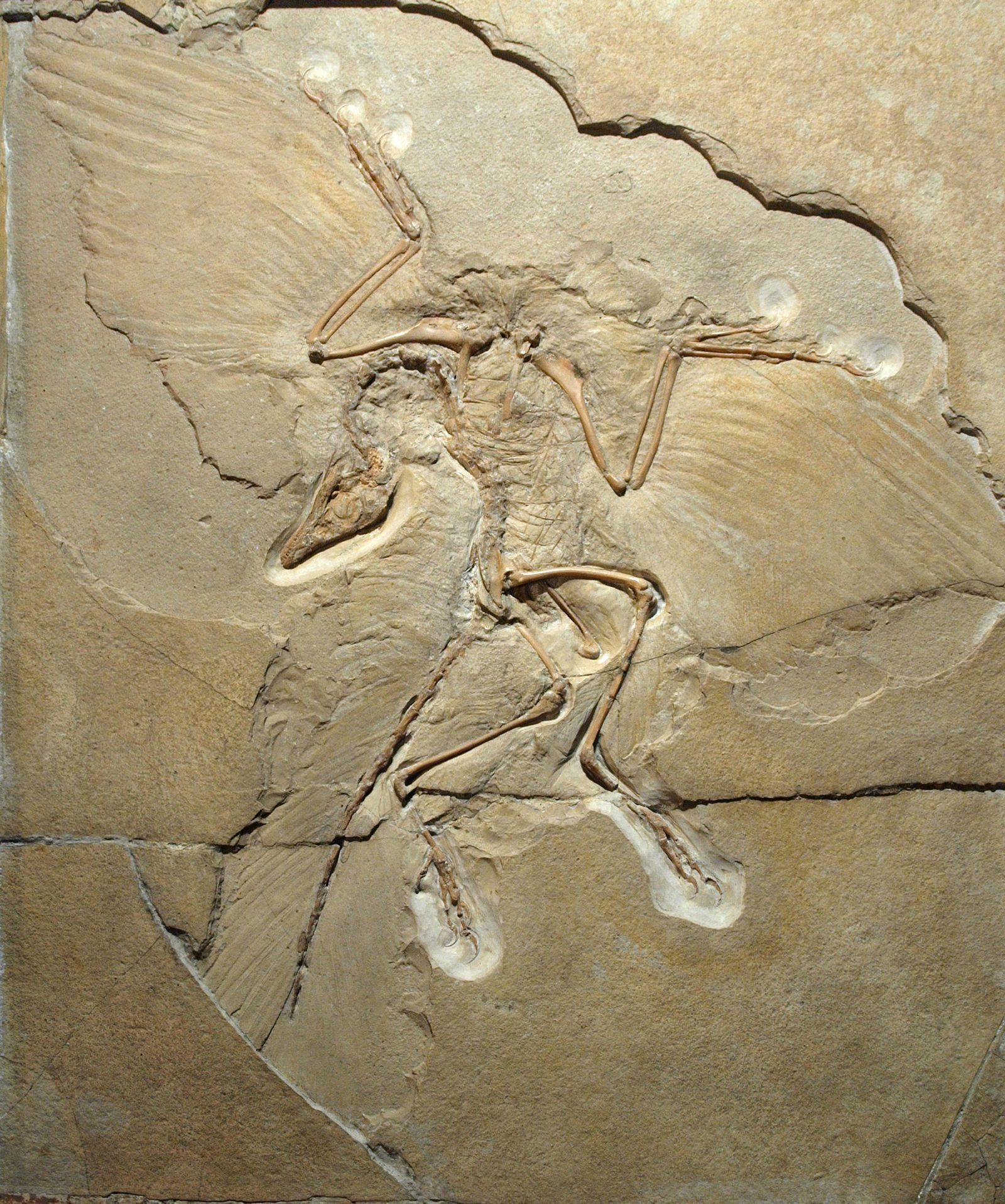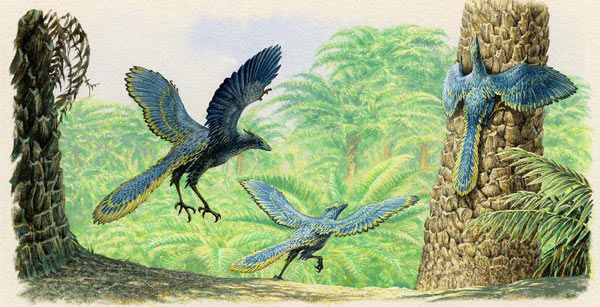Archaeopteryx - the missing link between dinosaurs and birds?
Archaeopteryx is an iconic fossil, often thought of as the 'missing-link' between dinosaurs and birds. It was first described in 1861 by the German palaeontologist Hermann von Meyer (1801-1869). Since then Archaeopteryx has been the focus of controversy surrounding the origin of birds and their links with dinosaurs.
Only eleven specimens and an isolated feather have so far been found, all coming from a few quarries near the Bavarian town of Solnhofen in southern Germany.
Almost all of the specimens are from the Solnhofen Limestone, fine muddy limestones deposited in tropical lagoons about 150 million years ago near the end of the Jurassic Period. One was found in the overlying Mörnsheim Formation and is younger by perhaps half a million years.

Archaeopteryx specimen - Museum für Naturkunde, Berlin, Germany
Discovery
In 1861 Hermann von Meyer published a description of a single fossil feather found in the Solnhofen Limestone and named it Archaeopteryx lithographica.
Archaeopteryxmeans 'ancient wing'. Von Meyer also mentioned that "an almost complete skeleton of an animal covered in feathers" had been found. After competition from other museums this skeleton was eventually bought by the British Museum along with other Solnhofen fossils for £700, then a huge sum of money.
In 1863 Richard Owen, Superintendent of the natural history collections at the British Museum described and illustrated the specimen declaring it be a bird with "rare peculiarities indicative of a distinct order". The discovery of this remarkable fossil came just two years after the publication of Charles Darwin's book, On the Origin of Species, which changed people's perception of the natural world.
Archaeopteryx seemed to fit well with Darwin's theory as it showed features of both birds and reptiles.
What did Archaeopteryx look like?
Archaeopteryx was a primitive bird with feathers, but its fossilised skeleton looks more like that of a small dinosaur. It was about the size of a magpie.
Unlike modern birds it had a full set of teeth, a long bony tail and three claws on its wing which may have been used for grasping branches. It lacked the fully reversed toes which enable many modern birds to perch. However, Archaeopteryx did have a wishbone, wings and asymmetrical 'flight' feathers, like a bird. It is likely that Archaeopteryx could fly, although perhaps not strongly.
Reconstruction of Archaeopteryx © J. Sibbick
The world of Archaeopteryx
Archaeopteryx lived on land near a series of stagnant and salty lagoons within a shallow tropical sea. Life in the lagoons was concentrated in the surface waters, as most of the lower levels were extremely toxic. It is possible that the only animals living in the lagoons were small floating crinoids (sea-lilies) and some fish.
Ammonites, shrimps, lobsters and starfish lived in the open sea nearby and were occasionally washed into the lagoons during storms. They did not survive for long in the lagoon waters. Horseshoe crabs have been found preserved at the end of a short trail of their own footprints. Very occasionally marine reptiles, such as ichthyosaurs and crocodiles, were also washed in.
Flying over the sea were pterosaurs and large insects such as dragonflies. These were blown into the lagoonal waters during these storms. A juvenile specimen of a small theropod dinosaur called Compsognathus has also been discovered in the same deposit, which must have been washed in from the land.

Reconstruction of Archaeopteryx. © J. Sibbick
How did Archaeopteryx die and become preserved?
Although Archaeopteryx lived on land, occasionally some would have been caught up in storms as they flew or glided over the water. Waterlogged and unable to take off again, they would have drowned and sunk to the floor of the lagoon.
All of the known specimens display various characteristics of immaturity, indicating that none of the specimens was fully adult. This may have been the reason for their inability to survive storm events.
The carcasses were quickly buried by fine lime muds deposited on the lagoon floors. It is thought that one metre of rock today represents 5,000 years of deposition. The fossils of Solnhofen are exceptionally preserved, due to the lack of disturbance from both predators and water movement. Within the fine grained limestones, delicate features such as dragonfly wings or the feathers of Archaeopteryx can be found.
Further reading:
Wellnhofer, P. 2009. Archaeopteryx the icon of evolution. Pfeil Verlag, Munich, 208 pp
Article by: Cindy Howells, Collections Manager (Palaeontology) & Caroline Buttler, Head of Palaeontology
Comments - (87)
I would have loved more differences between an archeopteryx and a modern bird
..this information means
a lot to me..
.I hope my teacher is going to be happy about this information